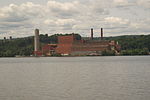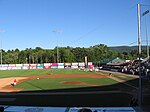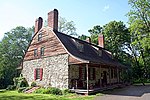Downstate Correctional Facility was a maximum-security prison in the Town of Fishkill in the Hudson Valley region of New York. It was located along the north side (i.e. westbound) of Interstate 84, opening in 1979 and closing in 2022.
Downstate served primarily as a classification center, as it was, along with Elmira Correctional Facility and Bedford Hills Correctional Facility (women), a reception facility for new inmates entering the New York State prison system. New inmates typically waited at Downstate for a few weeks before they were assigned to a permanent facility. The "permanent" prisoners—those who worked in the kitchens, laundry, etc., which those in transit could not do—were referred to as the "cadre" and were all maximum-security prisoners, with sentences of at minimum seven years. As the vast majority of inmates in New York State come from New York City, the Town of Fishkill, located in southern Dutchess County, was chosen as prison site due to its proximity to the greater New York metropolitan area.
Cells in Downstate were organized into four wings around a large and exactly square room called The Square, which was the junction point for the four wings and contained a staffed waiting room. Services such as reception, clothes, pharmacy, medical, commissary, chapel, mail, packages, visiting, and cafeteria were all centrally located, but there were small libraries in each of the wings. For many years, there was a softball field outside the prison building, used mainly by the cadre. Recreation could consist of an hour in a room with twenty other inmates and a television. Like all New York State prisons, there was a professional librarian, who supervised cadre workers at two locations, and a part-time rabbi. As with all maximum security prisons in New York State, inmate movement was scheduled and tightly controlled. An inmate who required medical attention had to be escorted to the infirmary by an officer. Shower opportunities were also scheduled. Library visits were short, scheduled, and in groups. There were dropboxes in the wings where prisoners being moved out of the facility, as most soon were after arrival, could deposit any library books that they had checked out.
Downstate was right across Interstate 84 from New York state's former psychiatric hospital, which since 1976 has been known as Fishkill Correctional Facility, a medium security prison. It was also adjacent to Dutchess Stadium, home field of the Hudson Valley Renegades.








